Bitcoin Cash (BCH) experienced a temporary decline in its three-month-long rally on Wednesday, but quickly recovered as the blockchain completed its second-ever halving. Halving is an event where mining rewards are halved. Bitcoin Cash is a cryptocurrency and blockchain network that was created to be faster and cheaper than Bitcoin (BTC). The first halving event for Bitcoin Cash occurred on April 8, 2020, reducing miner rewards from 12.5 BCH to 6.25 BCH.
Leading up to the halving, there was speculation about its impact, causing the price of Bitcoin Cash to increase by 147.85% in the past three months and 24% in the past 30 days. However, just before the halving, the price of Bitcoin Cash dipped by 9.94% to $572.21. Nonetheless, it quickly recovered after the halving, reaching $604, a 5.5% spike.
This recent price decline led to liquidations totaling $3.9 million, primarily affecting long positions at $3.3 million, while short positions accounted for $569,540.
The open interest (OI) in Bitcoin Cash futures perpetual contracts reached all-time highs of $708.75 million, as reported by Cointelegraph on March 29. Since then, the OI has continued to rise, reaching $799.23 million.
In the lead-up to the halving, many miners switched to mining Bitcoin instead of Bitcoin Cash, as mentioned by a user with the handle “DavidShares” to his 17,500 followers. Additionally, hash rates have declined since the halving, with only four blocks validated since the event.
Bitcoin Cash forked off from Bitcoin in 2017 due to disagreements within the community regarding scaling and transaction fees. Two years later, it split again, causing controversy among miners who had not upgraded to the new chain. This resulted in the wasteful allocation of resources.
The highly anticipated Bitcoin halving is scheduled to take place on April 20, just 16 days from now.

